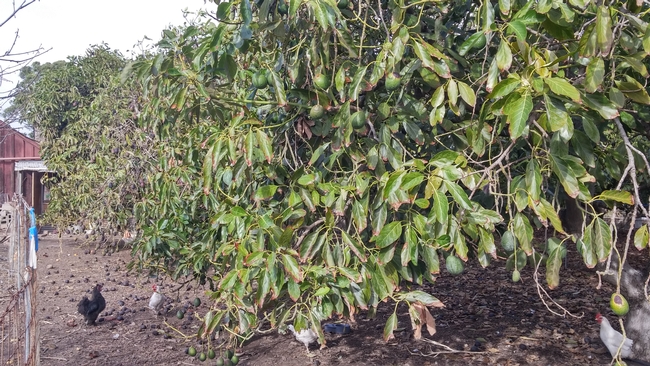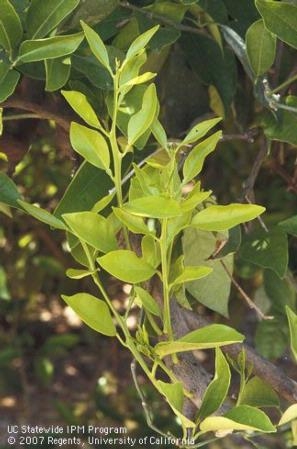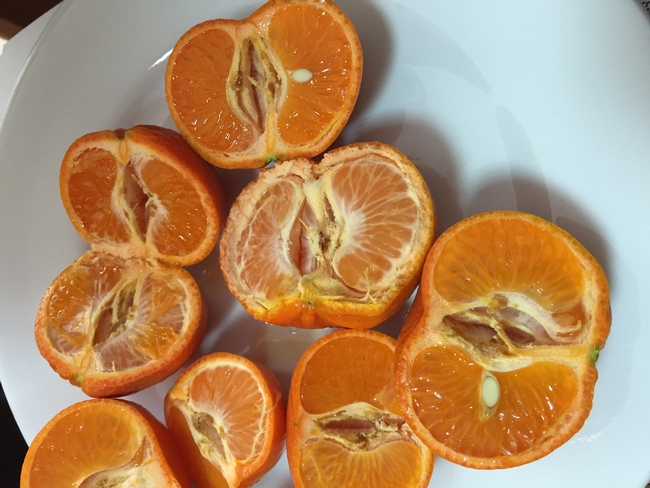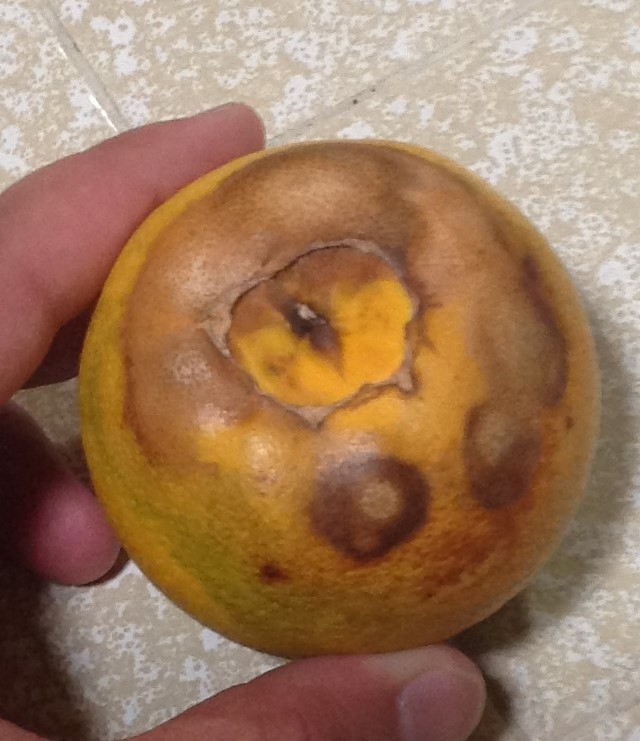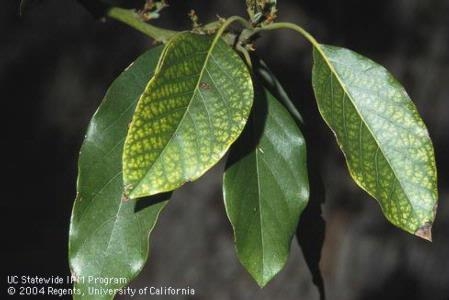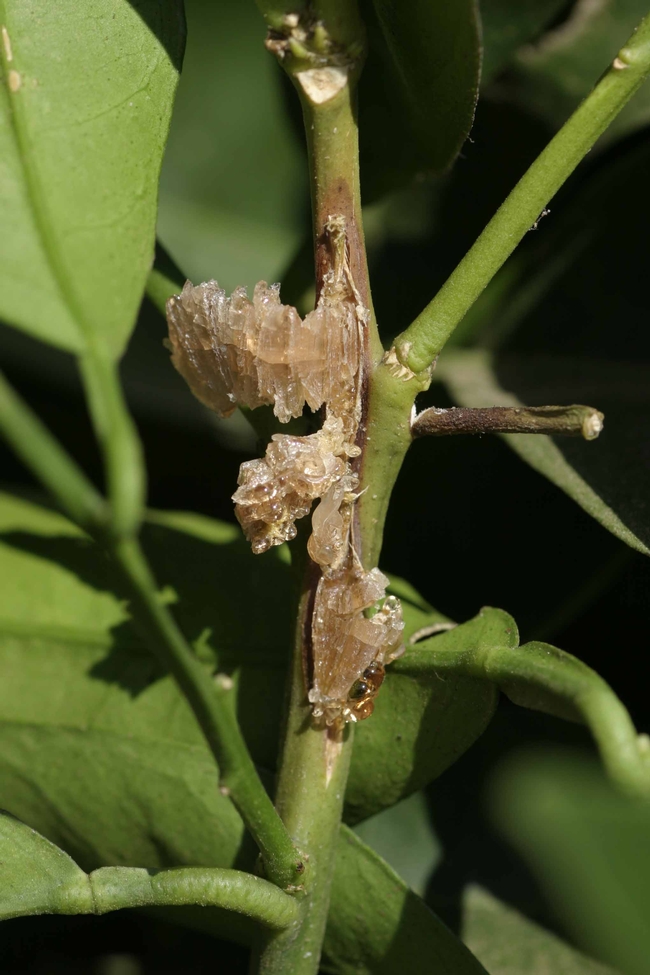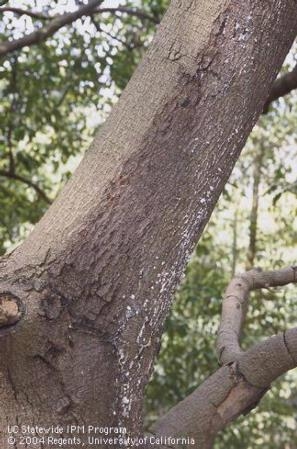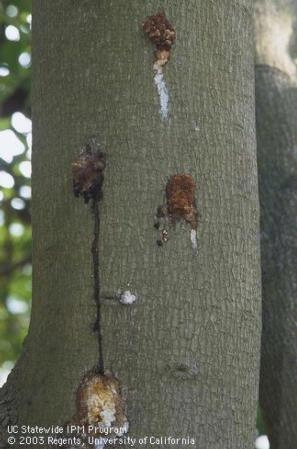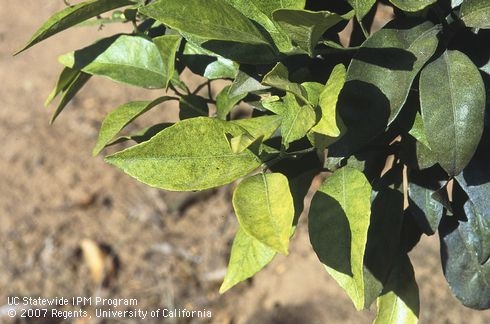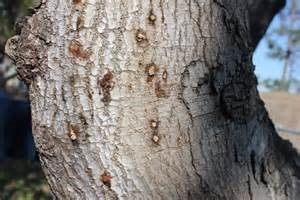Drought Induced Problems in Our Orchards
Abiotic disorders are plant problems that are non-infective. They are not caused by an organism, but through their damage, they may bring on damage caused by organisms. Think of a tree hit by lightning or a tractor. The damage breaches the protective bark which allows fungi to start working on the damaged area, eventually leading to a decayed trunk. It was the mechanical damage, though that set the process in motion.
Too much or too little water can also predispose a plant to disease. Think of Phytophthora root rot or even asphyxiation that can come from waterlogging or too frequent irrigations.
Salinity Effects from Lack of Water
Lack of water and especially sufficient rainfall can lead to salinity and specific salts like boron, sodium and chloride accumulating in the root zone. This happens from a lack of leaching that removes native soil salts from the root zone or the salts from the previous salt-laden irrigation from the root zone. These salts cause their own kind of damage, but they can also predispose a tree to disorders, disease and invertebrate (insect and mite) damage.
Lack of water and salt accumulation act in a similar fashion. Soil salt acts in competition with roots for water. The more soil salt, the harder a tree needs to pull on water to get what it needs. The first symptom of lack of water or salt accumulation may be an initial dropping of the leaves. If this condition is more persistent, though we start to see what is called “tip burn” or “salt damage”. Southern California is tremendously dependent on rainfall to clean up irrigation salts, and when rain is lacking, irrigation must be relied on to do the leaching
As the lack of leaching advances (lack of rainfall and sufficient irrigation leaching) the canopy thins from leaf drop, exposing fruit to sunburn and fruit shriveling.
Leaf drop and fruit shriveling in avocado.
In the case of sensitive citrus varieties like mandarins, water stress can lead to a pithy core with darker colored seeds, almost as if the fruit had matured too long on the tree.
Total salinity plays an important factor in plant disorder, but also the specific salts. These salts accumulate in the older leaves, and cause characteristic symptoms that are characteristic in most trees. Boron will appear on older leaves, causing an initial terminal yellowing in the leaf that gradually turns to a tip burn.
Often times it is hard to distinguish between chloride, sodium and total salinity damage. It is somewhat a moot point, since the method to control all of them is the same – increased leaching. There is no amendment or fertilizer that can be applied that will correct this problem. The damage symptoms do not go away until the leaf drops and a new one replaces it. By that time hopefully rain and/or a more efficient irrigation program has been put in place.
The Impact of Drought on Nutrient Deficiencies
Salinity and drought stress can also lead to mineral deficiencies. This is either due to the lack of water movement carrying nutrients or to direct completion for nutrients. A common deficiency for drought stressed plants is nitrogen deficiency from lack of water entraining that nutrient into the plant.
This usually starts out in the older tissue and gradually spreads to the younger tissue in more advanced cases.
The salts in the root zone can also lead to competition for uptake of other nutrients like calcium and potassium. Apples and tomatoes are famous for blossom end rot when calcium uptake is low, but we have also seen it in citrus. Low calcium in avocado, and many other fruits, leads to lower shelf life. Sodium and boron accumulation in the root zone can lead to induced calcium deficiencies and increased sodium can also further lead to potassium deficiencies. Leaching can help remove these competitive elements.
Drought Effect on Tree Disease
Drought and salt stress can also lead to disease, but in many cases once the problem has been dealt with the disease symptoms slowly disappear. They are secondary pathogens and unless it is a young tree (under three years of age) or one blighted with a more aggressive disease, the disease condition is not fatal. Often times, in the best of years, on hilly ground these diseases might be seen where water pressure is lowest or there are broken or clogged emitters. The symptoms are many – leaf blights, cankers, dieback, gummosis – but they are all caused by decomposing fungi that are found in the decaying material found in orchards, especially in the naturally occurring avocado mulch or artificially mulched orchards. Many of these fungi are related Botryosphaerias, but we once lumped then all under the fungus Dothiorella. These decay fungi will go to all manner of plant species, from citrus to roses to Brazilian pepper.
Another secondary pathogen that clears up as soon as the stress is relieved is bacterial canker in avocado. These ugly cankers form white crusted circles that ooze sap, but when the tree is healthy again, the cankers dry up with a little bark flap where the canker had been.
Drought Effect on Pests
Water/salt stress also makes trees more susceptible to insect and mite attack. Mites are often predated by predacious mites, and when there are dusty situations, they can't do their jobs efficiently and mites can get out of hand. Mite damage on leaves is often noted in well irrigated orchards along dusty picking rows
Many borers are attracted to water stressed trees and it is possible that the Polyphagous and Kuroshio Shot Hole Borers are more attracted to those trees.
And then we have conditions like Valencia rind stain that also appears in other citrus varieties. We know it will show up in water stressed trees, but we aren't sure what the mechanism that causes this rind breakdown just at color break. Could it be from thrips attracted to the stressed tree or a nutrient imbalance, it's not clear?
Water and salt stress can have all manner of effects on tree growth. It should lead to smaller trees, smaller crops and smaller fruit. The only way to manage this condition is through irrigation management. Using all the tools available, such as CIMIS, soil probes, soil sensors, your eyes, etc. and good quality available water are the way to improve management of the orchard to avoid these problems.
Scroll down for Images
Tip Burn, notice sun burn bottom right hand fruit
Endoxerosis with dried out core
Boron toxicity
Nitrogen deficiency
Blossom end rot
Potassium deficiency
Bot gumming in lemon
Black Streak in Avocado
Bacterial Canker
Citrus red mite
Polyphagous Shot Hole Borer damage on avocado
Valencia Rind Stain
- abiotic
- abiotic
- avocado
- avocado
- biotic
- biotic
- blight
- blight
- blossom end rot
- blossom end rot
- boron toxicity
- boron toxicity
- calcium deficiency
- calcium deficiency
- canker
- canker
- citrus
- citrus
- disease
- disease
- drought
- drought
- nutrient competition
- nutrient competition
- nutrient interactions
- nutrient interactions
- pests
- pests
- Phytophthora
- phytophthora
- Phytophthora
- phytophthora
- potassium deficiciency
- potassium deficiciency
- PSHB
- PSHB
- rind stain
- rind stain
- salt damage
- salt damage
- tip burn
- tip burn
- water stress
- water stress
Attached Images:
